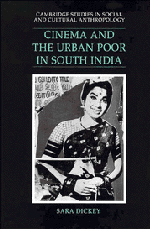10 - Conclusions
from Part III
Published online by Cambridge University Press: 24 October 2009
Summary
Critics castigate Tamil film for artificiality, for its distance from reality. The lack of the real is, as Silverman (1988) argues, intrinsic to cinema, but these critics' complaints focus on what is in fact a rather trite artificiality, and miss cinema's connections to the real. Films draw heavily from reality, portraying situations that bear remarkable resemblance to the everyday stresses and aspirations of viewers' lives. Audiences recognize the links. They see connections between their lives and films in both general and specific terms, apply morals to parallel circumstances, and remark on the impact that cinema has on lives not divorced from it.
That they do all this in very personal terms highlights the lack of collective lessons drawn in or from melodrama, a result in part of the genre's emotional structure. Melodrama draws suppressed fears and desires into a public realm, but suggests personal solutions. While giving concrete form to anxieties caused by shared socioeconomic circumstances, it rarely advocates collective solutions. In fact, as we have seen, far from encouraging collective efforts, films may imply that no effort at all is required for the removal of obstacles. Nor do viewers make the connection back to class discrepancies, one of the predominant sources of their problems, the very problems they attend films in order to escape. While they clearly recognize connections between their lives and movies and derive morals that can be applied to their lives, they do all this in thoroughly personal terms.
- Type
- Chapter
- Information
- Cinema and the Urban Poor in South India , pp. 173 - 176Publisher: Cambridge University PressPrint publication year: 1993



